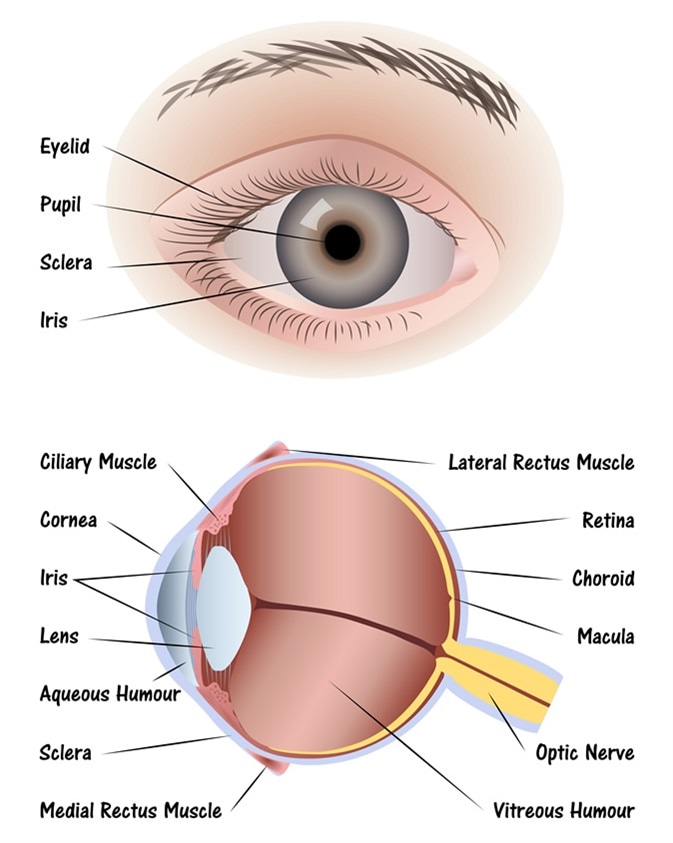
Anatomy of the Human Eye
Eyes are one of the most important organs of the body. A healthy pair of eyes means a clear vision, which plays a major role in day-to-day life and quality of experiences.
Humans have binocular vision, meaning that both the eyes create a single combined image. Optical components create an image, which further gets perceived and interpreted by the brain via connecting neurons. The entire machinery works in quite an intricate manner.
Structural Components of the Eye
This biological camera is made up of:
External Components
Eyelids are the outermost protective parts of the eye. They act as ‘shutters’ and primary barriers against external environment. Boundaries of eyelids are covered by tiny hairline termed as eyelashes.
As we go past eyelids, the next component is the circular frontage of the spherical eyeball, termed as cornea. Cornea is the first optical component of the eye machinery, dealing first-hand with the incoming light. Its function is of a primary filter, before passing on the light to the lens and retina.
The central portion of the front of the eyeball is termed as iris. Iris is a pigmented structure. Eye color (black, brown, blue etc.) is defined by the pigmentation of iris. The central aperture of iris is called pupil. It is circular in shape, and allows light to pass through onto the lens. Just like the aperture of a camera, it controls the amount of light that goes in. In bright environments, the pupil of the eye constricts, while in dark environments, it dilates. The process of dilatation and constriction of pupil is not instantaneous. This is the reason we can’t see anything for few moments when we enter from bright sunlight to a dark interior, and also the reason we can’t keep our eyes wide open when we suddenly switch on the lights in the middle of the night.

Human Eye Diagram. Image Credit: Pablofdezr / Shutterstock
Internal Components
Located right behind the pupil is the transparent structure termed as the lens, responsible for correct focusing of the visuals. It is flexible in nature, and adjusts according to the external lighting. The lens is encapsulated in a thin transparent body, and is connected with the eyeball by a pair of muscles. It refracts the light, and helps in focusing it correctly to the back of the eyeball (retina).
Retina is the innermost layer of the eyeball structure. Retinal membrane can be imagined as the wall on which the images are projected. The light passing through cornea, pupil, and lens gets focused on the retinal membrane. In addition to tissue components, retina is made up of two types of cells: rod cells and cone cells. The former are considered to be responsible for dim light vision, whereas the latter are considered to be responsible for bright light vision. Cones play a critical role in perception of the images with sharp contrast. Deficiency of either type of cells would cause abnormalities in the ocular function.
Retinal membrane contains an area called macula, which is yellow in color. The center of macula is called fovea, which contains the highest concentration of cone cells. The part of the image projected on the fovea is usually the most accurately registered visual memory.
Sclera is the outermost white colored protective coat of the eyeball. It is essentially tougher compared to the delicate internal structures within the eyeball.
Choroid is the middle layer of the eyeball wall, sandwiched between retina and sclera. It also helps in clarity of vision by absorbing excess light. The muscles which attach sclera to the iris are termed as ciliary body, which play a role in flexible focusing of the image through the lens.
Once the incoming light is filtered, reflected, and refracted appropriately to produce an image on the back of the eyeball, the neurological systems come into the play. The part of the optic nerve that is attached to the back of the eyeball is named as optic disc. This is the region where rod cells and cone cells are least in the concentration, and therefore, any image projected to this area is often missed. It is also called a ‘blind spot’ due to this reason. Optic nerves connecting the eyeballs to the brain are responsible for transmitting the visuals to the brain, where they are processed into the meaningful information.
The complexity of the anatomy of the eye is immense, and despite being considered a well-understood structure, newer knowledge about it keeps surfacing during ongoing research.
Sources
Further Reading
Last Updated: Sep 24, 2018






















.png)









No hay comentarios:
Publicar un comentario